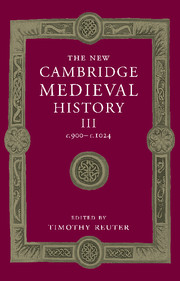Book contents
- Frontmatter
- 1 Introduction: reading the tenth century
- PART I GENERAL THEMES
- 2 Rural economy and country life
- 3 Merchants, markets and towns
- 4 Rulers and government
- 5 The Church
- 6 Monasticism: the first wave of reform
- 7 Intellectual life
- 8 Artists and patrons
- PART II POST-CAROLINGIAN EUROPE
- PART III NON-CAROLINGIAN EUROPE
- Appendix genealogical tables
- List of primary sources
- Bibliography of secondary works arranged by chapter
- Index
- Frontispiece
- Plate section
- Map 2: Archbishoprics and bishoprics in the early eleventh century
- Map 4: Germany
- Map 13: Byzantium in 1025
- References
6 - Monasticism: the first wave of reform
from PART I - GENERAL THEMES
Published online by Cambridge University Press: 28 March 2008
- Frontmatter
- 1 Introduction: reading the tenth century
- PART I GENERAL THEMES
- 2 Rural economy and country life
- 3 Merchants, markets and towns
- 4 Rulers and government
- 5 The Church
- 6 Monasticism: the first wave of reform
- 7 Intellectual life
- 8 Artists and patrons
- PART II POST-CAROLINGIAN EUROPE
- PART III NON-CAROLINGIAN EUROPE
- Appendix genealogical tables
- List of primary sources
- Bibliography of secondary works arranged by chapter
- Index
- Frontispiece
- Plate section
- Map 2: Archbishoprics and bishoprics in the early eleventh century
- Map 4: Germany
- Map 13: Byzantium in 1025
- References
Summary
in every medieval century in Europe monastic life was renewed, and renewal might indeed be said to have been a characteristic of medieval monasticism. Yet although there is a rich literature on Carolingian monastic reform in the age of Charles the Great and Louis the Pious, for example, it has become customary to describe the monasticism of the tenth and eleventh centuries as ‘reform monasticism’, just as one talks of the ‘reform papacy’ and of the ‘era of reform’. Is there not here perhaps an inherent contradiction, just as there is in the chapter-title, suggested by the editor of this volume? For if one talks of a ‘first wave of reform’ in connection with the monasticism of the tenth and eleventh centuries, then this must imply, considering how much we know about Carolingian monastic reform, that tenth-century reform was a much deeper caesura in the history of medieval monasticism, a fundamentally new beginning. Recently Gerd Tellenbach has described the period from the ninth to the eleventh century as ‘the great era of monasticism’, but he did not talk of reform monasticism and indeed he questioned the notion of monastic decadence in the tenth century There were indeed many monasteries ruined by warfare, and in west Francia they suffered not only from Norse attacks but also from the long-drawn-out transition from Carolingian to Capetian rule with its concomitant transfer of power from an increasingly weak centre to local and regional lordships, a process which afflicted monasteries in particular. It is probably no accident that it was precisely in Aquitaine, Burgundy and Lotharingia that expectations of the coming end of the world emerged decades before the critical year 1000.
Keywords
- Type
- Chapter
- Information
- The New Cambridge Medieval History , pp. 163 - 185Publisher: Cambridge University PressPrint publication year: 2000
References
- 4
- Cited by

